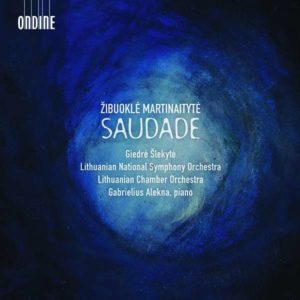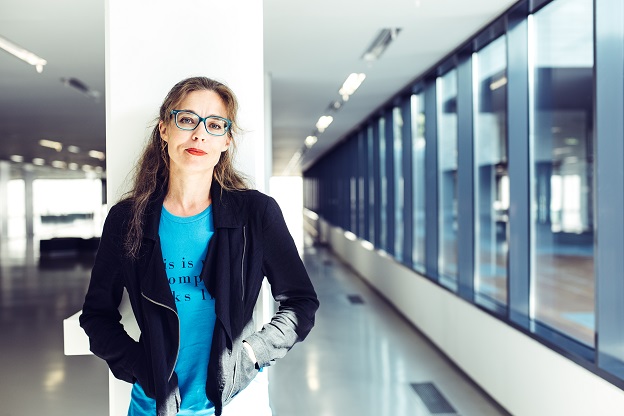You were born in St. Petersburg, grew up in Kaunas and now live in New York. To what extent have these places left traces in your compositions?
Places we live in influence our way of being, our communication and the way we relate to others and undoubtedly influence our innermost artistic expression. In my case it is not always easy to trace these influences because altogether they create a mixture… a new entity.I can distinguish a few threads that are woven into my compositions in varying proportions. One is this restless forward motion that seemingly finds no resolution – this feature I associate with living in a large metropolis such as St. Petersburg, Russia, or New York City. In addition to speed and anxiety that are common to big cities, there is also an incredible density of people and events that are happening simultaneously at all times. This density found a way into my musical textures that consist of a multiplicity of layers. As a contrast to this comes a spaciousness of sound, a meditative quality of slow time that can be related to living in smaller, less populated environments such as Lithuania. Climate conditions can also play a part in our living experience. Lithuania has a very long winter with not much natural light, and it also has quite a lot of rain. All this transpires into a somewhat melancholic, nostalgic emotional terrain that my music naturally inhabits.
You received the Guggenheim Fellowship and won the Lithuanian Government Award in 2020, it seems you commute back and forth between the New World (USA) and your old homeland Lithuania. The Baltic countries have developed a unique national identity and (musical) culture in Europe. To what extent do you tie in with the musical language of your homeland in your works? Would you describe yourself as a (typically) Lithuanian composer?
My cultural roots are in Lithuania and I think it is quite audible in my music, especially in the harmonic choices. There is a gravitational pull towards certain harmonic modes, prioritizing intervals that sound most organic to me. This comes as an inherent manifestation of the DNA of a harmonic language common to the Baltic region. Although moving to the USA definitely added new layers of influences and resulting perceptions, it hasn’t removed my cultural identity as a Lithuanian composer, but rather expanded it into a new and larger dimension.
 On your new CD Saudade we hear orchestral music from you. Can you express yourself best in the orchestral language? Or are all genres equally important to you?
On your new CD Saudade we hear orchestral music from you. Can you express yourself best in the orchestral language? Or are all genres equally important to you?
The orchestral palette is my favorite to compose for. It offers such a multitude of possibilities for mixing instrumental timbres and for layering textures. Working with orchestral colors has become one of the essential structuring principles of my music. The color of the sound, its gradual change and layering of it is much more important for me than forming a melodic gesture. For example, I can have a simple harmonic pattern as an underlying stable foundation and then on top of it I start varying the gradations of orchestral colors as well as the density of texture. These processes are so fascinating that they can keep the listeners ears and brains engaged without any need for a more significant changes in the musical flow. Thus, seemingly static textures become radiantly alive through the continuous changes on the micro level.
All four works on the CD have titles like Horizons. Would you say that these compositions are program music in the broadest sense? What do the titles mean to you? Are they meant to draw the listener’s attention in a certain direction?
Titles of the pieces are very often foreign words that trigger my imagination with a set of meaning ascribed to them. The concepts or emotional territories that we are invited to by these words are quite broad. Therefore, the general direction is definitely there, but the journey is unveiled only through the music itself, which provokes the emotional memories or imaginative dreams within the listener’s mind. If we take the piece Saudade as an example, this Portuguese word stands for nostalgia. Yet it is not only simply understood as longing for something we don’t have or have lost, but it is almost a metaphysical category, a meta-longing for the existence we’ve never experienced. The title is only a hint for what we will hear in the piece, which I would otherwise describe as variations and explorations of longing. There is this haunting motif at the beginning, a melody that undergoes incredible transformations in colour, register and texture – from the timbral variations to the expansion into the extreme registers, where the sound becomes indistinguishable from noise, from easily perceivable melodic gestures to overwhelmingly huge masses of sound or almost immaterial and transparent sonic textures. The same as the emotion of longing which can express itself in a myriad of ways – from quiet sadness to a violent outburst that happens in our dreams.
In all four compositions that can be heard on the CD, you tie in with procedures of the musical avant-garde, yet the works never sound coldly constructed or even emotionless, on the contrary. Would you describe yourself as a postmodern artist? Or is it precisely in this that your Baltic heritage comes through? Because pure atonality and seriality never really prevailed in the Baltic.
Yes. I would agree on this description of being a postmodern artist. In my early years of composing, I was interested in complex structures of music and I was trying to make my music sound more modern with the overuse of extended instrumental techniques. I was prioritizing the means instead of the content. This attitude toward music was radically changed by my father’s untimely death. I was reminded of our impermanent nature as human beings and somehow in that light I came to the realization that I should not be ashamed of or hiding my emotions. To be a composer means not only using one’s brain, but also not forgetting about one’s heart. I wanted to be myself fully in my music without any pretense. I had to be honest with myself and others. This involved my emotions as well as my intellect and structural thinking through which the emotions are mediated. On the other hand, as you pointed out, the pure atonality and serialism was never the main style of music in the Baltics even though we had some representation of it.
We don’t hear the works on the CD in the order in which they were written. Is there a reason for the arrangement?
The works on the CD are arranged not in an historic sequential order, but in such a way that it would make sense as a coherent emotional journey for the listener. As though these 4 pieces together make a new meta-piece. This logic is also common when curating a concert program where you do not put two similar pieces next to one another, but rather, illuminate their differences through juxtaposition. It is only natural that after having some deeply moving musical experience, we wish to rest for a bit and to have something that is easily ‘digestible’ or more pleasant to our ears. This CD starts with Saudade, which can be quite an intense emotional journey. The second piece Millefleur provides a balancing act – I describe it as ‘acoustic hedonism’, as a walk in a beautiful sonic garden. Also, sometimes the idea presented in the ending of one piece can become an entrance point to the next piece. For instance, Millefleur ends with this expansive spacious atmosphere that resonates with the whole idea of Horizons, the third piece on the album. The decision of this particular order of pieces was the combined creative effort of the producer, recording engineers and myself.
The CD recording was made in 2020 under lockdown conditions. Did the silence of the lockdown enter into the recording? It sometimes seems that way to me when I listen to Saudade or, above all, the incredibly enchanting composition Millefleur…
I think the lockdown has definitely left a mark on this recording. A very special atmosphere was felt during our recording sessions at the Lithuanian National Philharmonic in Vilnius. After the first wave of the pandemic in Lithuania, musicians have missed playing together and hearing music not only through their devices, but as a live physically present sound. That is why they really appreciated and cherished every moment of togetherness as an orchestra and the resultant spiritual feeling was transferred into the music. That experience of isolation was transformed instantly into an almost euphoric yet somewhat fragile sense of unity on a human level. Music does bring people together and in this case it did it for real. One can hear it when listening to this album.

























